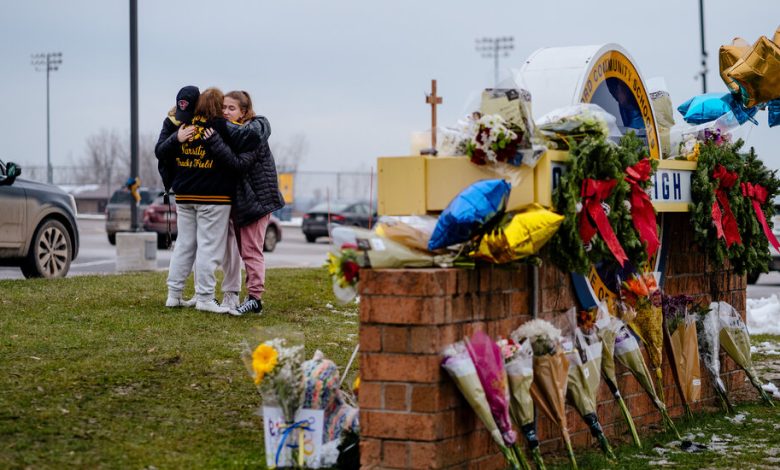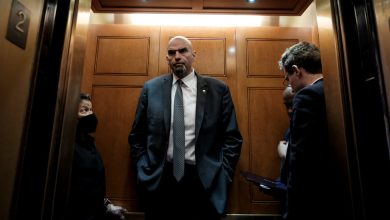In Oxford School Shooting, Safety Policies Were Overlooked, Say Ex-Board Members

A year after a shooting that killed four students at Oxford High School in Michigan, the school district and broader community are still wrestling with painful questions about how, or whether, the rampage could have been prevented.
On Monday, two of the district’s former board members pointed to safety procedures that they said should have been carried out in the years before the Nov. 30 shooting, but were not.
The former members — Tom Donnelly, who was the board’s president, and Korey Bailey, who was its treasurer — said they resigned in September so that they could speak more freely about the tragedy and its aftermath.
They said that the district had failed to fully establish threat assessment policies that had been approved for over a decade, and that putting these policies into practice could have ensured that trained teams were in place to respond to early signs of danger. Ideally, they said, the process of monitoring threats and preventing shootings should have been a subject of regular training and practice.
“The state requires fire drills several times per year, but they are silent on requiring the same emphasis on school threat assessment,” Mr. Bailey said. “I believe that Oxford has a moral and ethical obligation to not only learn from their failures, but to use this tragedy as a loud voice to other districts.”
Mr. Donnelly also said that a completed assessment from a third-party investigator was overdue. “To this day, we have not independently reviewed the events from the start of the school year to the 30th of November 2021,” he said. Guidepost Solutions, a security consulting firm hired by the district to do the assessment, said that an initial report was expected early next year.
Dan D’Alessandro, the president of the district’s board of education, said in an emailed statement that “the review will help us all understand the facts and have the transparency and accountability we all deserve.”
The district regularly held drills to teach students how to stay safe during a shooting, using a practice known as ALICE: “alert, lockdown, inform, counter and evacuate.” After the shooting, the local authorities said that students, staff members and police officers had acted exactly as they had been trained to. But criticism of such drills has grown in recent years, with parents and some researchers questioning whether they can be counterproductive or hurt children’s mental health.
Last month, Ethan Crumbley, 16, who was a student at the school, admitted to killing Tate Myre, 16; Justin Shilling, 17; Madisyn Baldwin, 17; and Hana St. Juliana, 14, as well as injuring seven other people, including six students and a teacher, in the shooting. He pleaded guilty to 24 counts, including murder, attempted murder, terrorism and weapons violations.
Local prosecutors also took the rare step of filing charges against Ethan’s parents, James and Jennifer Crumbley, saying that they were culpable because they had allowed their son access to a handgun while ignoring warnings that he was on the brink of violence. The parents pleaded not guilty to charges of involuntary manslaughter and face trial in January.
James Crumbley purchased a semiautomatic pistol for his son on Nov. 26, 2021, the day after Thanksgiving, the authorities said.
At school three days later, on a Monday, a teacher reported seeing Ethan Crumbley searching online for ammunition. On Nov. 30, an alarming note was found on his desk. “The thoughts won’t stop,” it said. “Help me.”
School officials met with Mr. Crumbley and his parents, who resisted bringing him home, prosecutors said. The shooting happened shortly thereafter.
Mr. Donnelly said Guidepost, which was hired in May to review the events surrounding the shooting, quickly began to face obstacles. “Roadblocks were put in their path,” he said, adding that the review process had been directed by the school board but “undercut by our own counsel.”
Mr. Donnelly also suggested that the district’s insurance company may have played a role in the delay, but he and Mr. Bailey declined to elaborate further on who was most responsible for delaying third-party investigations, citing ongoing litigation against the district.
The executive vice president of Guidepost, Bradley Dizik, said in an email after the news conference that the concerns shared by the former Oxford school board members “are included in the scope of the independent investigation.”
At a school board meeting last week, Mr. Dizik said that Guidepost had yet to speak with some “critical witnesses,” adding that he expected a law firm associated with the district’s insurance carrier to make those witnesses available after their depositions in court proceedings.
The law firm, Giarmarco, Mullins & Horton, said in an emailed statement on Monday that “multiple staff members received threat assessment training before the Nov. 30 tragedy,” and that “many of the former board members’ allegations show a misunderstanding of the facts.” It added that more would be revealed in the ongoing litigation.
Mr. D’Alessandro said that participation in the Guidepost investigation was growing.
“I want to be clear: The board is made up of good people who wanted to do the right thing,” Mr. Bailey said. “But they were convinced by voices outside of our district that they needed to wait and that coming forward would only bankrupt the district and potentially tear this community apart.”





